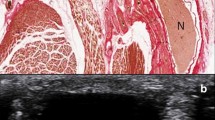Summary
Experimental induction of subarachnoid haemorrhage in rats resulted in acute haemodynamic changes. Heart rate decreased concomitantly with a rise in arterial blood pressure. Intracranial pressure increased and consequently cerebral perfusion pressure dropped. These changes as well as the observed electrocardiographic (ECG) changes were comparable to those reported in patients. Apart from blood also saline, when introduced into the cisterna magna, was able to elicit such abnormalities. The haemodynamic and electrocardiographic changes, which result from subarachnoid haemorrhage, may even become aggravated, when repetitive injections of blood or saline are given into the cisterna magna and when cerebral angiography is performed prior to induction of the subarachnoid haemorrhage. Chronic intracranial pressure monitoring during the 48 hours following subarachnoid haemorrhage revealed no significant rise in pressure.
A thorough control of the experimental conditions is thus of utmost importance in order to give a valid interpretation of the observed anomalies.
Similar content being viewed by others
References
Andreoli A, di Pasquale G, Pinelli G, Grazi P, Tognetti F, Testa C (1987) Subarachnoid hemorrhage: frequency and severity of cardiac arrhythmias. Stroke 3: 558–564
Breks JWF (1980) Cerebral vasospasm and increased intracranial pressure. In: Wilkins RH (ed) Cerebral arterial spasm. Williams & Wilkins, Baltimore London, pp 412–413
Brouwers PJAM, Wijdicks EFM, Hasan D, Vermeulen M, Wever EFD, Frericks H, van Gijn J (1989) Serial electrocardiographic recording in aneurysmal subarachnoid hemorrhage. Stroke 20: 1162–1167
Choo MH, Chia BL, Tan L (1985) Stroke masking electrocardiographic abnormalities. J Electrocardiography 18: 405–408
Cushing H (1902) Some experimental and clinical observations concerning states of increased intracranial tension. Am J Med Sci 124: 375–400
Fentz V, Gormsen J (1962) Electrocardiographic patterns in patients with cerebrovascular accidents. Circulation 25: 22–28
Harrison MT, Gibb BH (1964) Electrocardiographic changes associated with a cerebrovascular accident. Lancet 2: 429–430
Hugenholtz PG (1962) Electrocardiographic abnormalities in cerebral disorders. Report of six cases and review of the literature. Am Heart J 63: 451–461
Koskelo P, Punsar S, Sipilä W (1964) Subendocardial haemorrhage and ECG changes in intracranial bleeding. Br Med J 1: 1479–1480
Lacy PS, Earle AM (1983) A small animal model for electrocardiographic abnormalities observed after an experimental subarachnoid haemorrhage. Stroke 14: 371–377
Marion DW, Segal R, Thompson ME (1986) Subarachnoid hemorrhage and the heart. Neurosurg 18: 101–106
Menon IS (1964) Electrocardiographic changes simulating myocardial infarction in cerebrovascular accident. Lancet 2: 433–434
Nakamura Y, Kaseno K, Kubo T (1989) Transient ST-segment elevation in subarachnoid hemorrhage. J Electrocardiol 22: 133–137
Neil-Dwyer G, Cruickshank JM, Doshi R (1990) The stress response in subarachnoid haemorrhage and head injury. Acta Neurochir (Wien) [Suppl] 47: 102–110
Neil-Dwyer G, Walter P, Cruickshank JM, Doshi B, O'Gorman P (1978) Effect of propranolol and phentolamine on myocardial necrosis after subarachnoid haemorrhage. Br Med J 2: 990–992
Parizel G (1973) Life-threatening arrhythmias in subarachnoid haemorrhage. Angiology 24: 17–21
Solomon RA, Antunes L, Chen RYZ, Bland L, Chien S (1985) Decrease in cerebral blood flow in rats after experimental subarachnoid haemorrhage: a new animal model. Stroke 16: 58–64
Srivastava SC, Robson AO (1964) Electrocardiographic abnormalities associated with subarachnoid haemorrhage. Lancet 2: 431–433
Stober T, Anstätt Th, Sen S, Schimrigk K, Jäger H (1988) Cardiac arrhythmias in subarachnoid haemorrhage. Acta Neurochir (Wien) 93: 37–44
Verlooy J, Selosse P, Van Reempts J, Haseldonckx M, Borgers M (1990) Fiberoptic intracranial pressure monitoring in rats. J Neurosci Meth 31: 1–6
Verlooy J, Van Reempts J, Haseldonckx M, Borgers M, Selosse P Vertebrobasilar angiography following subarachnoid haemorrhage in rats. Acta Neurochir (Wien), submitted
Weintraub RM, Mc Henry LC (1974) Cardiac abnormalities in subarachnoid haemorrhage. A resume. Stroke 5: 384–392
Uchida M, Saito K, Niitsu T, Okuda H (1989) Model of electrocardiographic changes seen with subarachnoid hemorrhage in rabbits. Stroke 20: 112–118
Yuki K, Kodama Y, Onda J, Emoto K, Morimoto T, Uozumi T (1991) Coronary vasospasm following subarachnoid haemorrhage as a cause of stunned myocardium. J Neurosurg 75: 308–311
Author information
Authors and Affiliations
Rights and permissions
About this article
Cite this article
Verlooy, J., Van Reempts, J., Haseldonckx, M. et al. Haemodynamic, intracranial pressure and electrocardiographic changes following subarachnoid haemorrhage in rats. Acta neurochir 115, 118–122 (1992). https://doi.org/10.1007/BF01406369
Issue Date:
DOI: https://doi.org/10.1007/BF01406369




